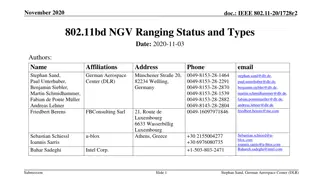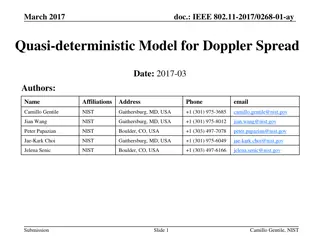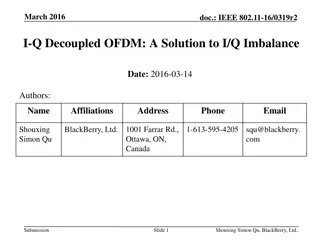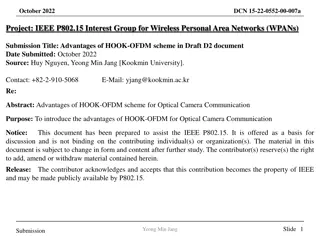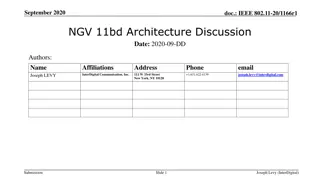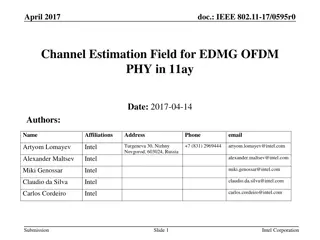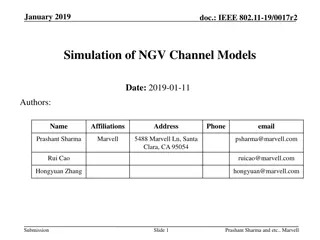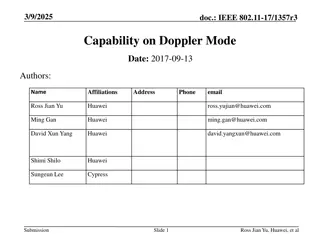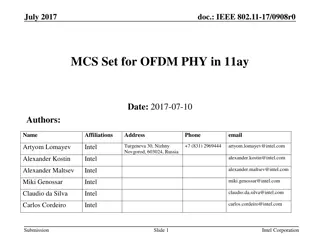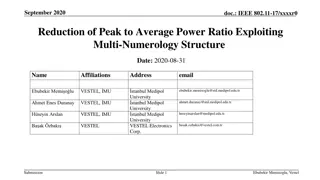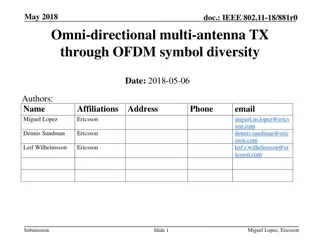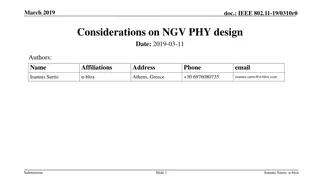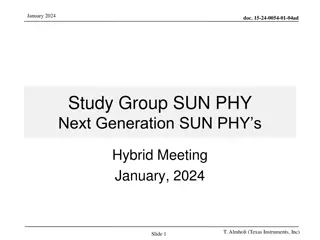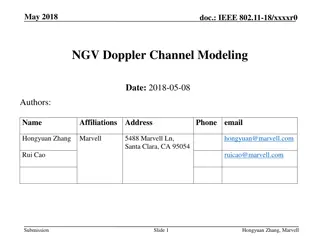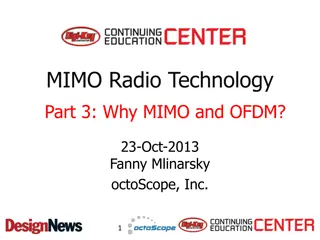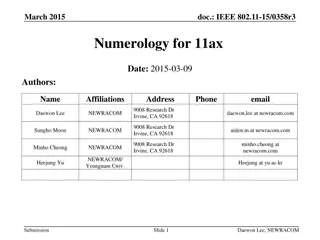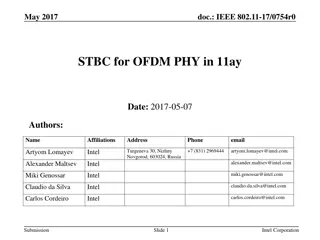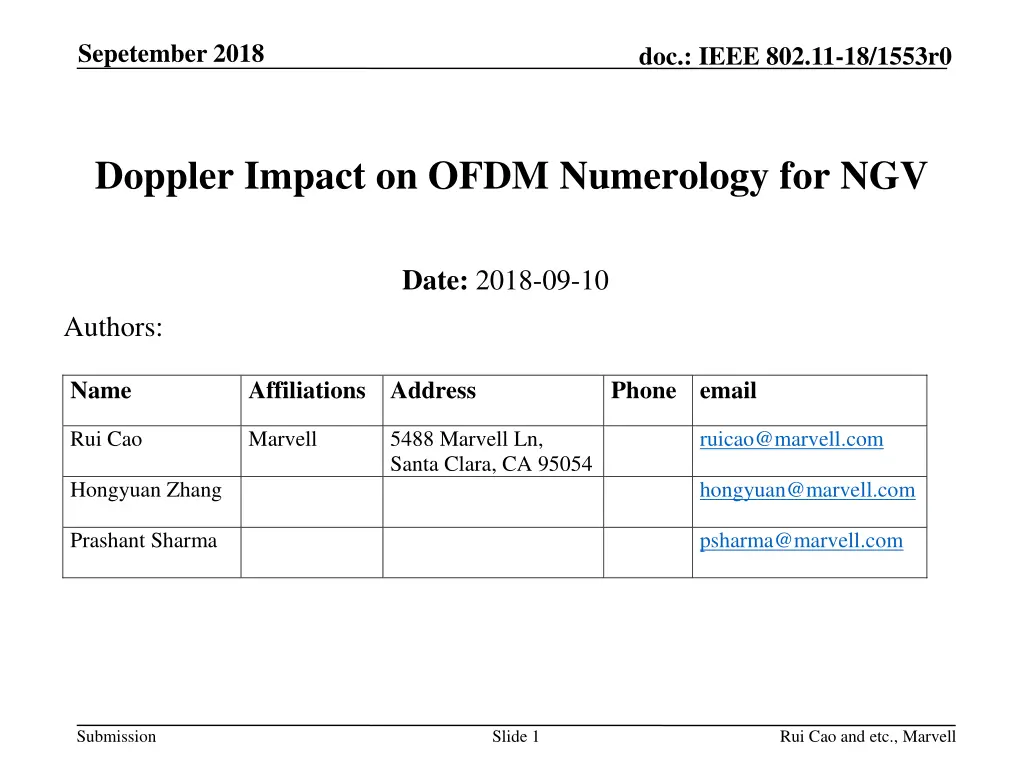
Impact of Doppler on OFDM Numerology for NGV
"Explore the effect of Doppler on designing Next-Generation Vehicles (NGV) tone numerology using existing IEEE 802.11 technology advancements. Analyze Doppler's influence on channel variation, inter-subcarrier interference, and OFDM efficiency. Consider practical challenges and solutions for managing Doppler-induced issues in vehicular communications."
Download Presentation

Please find below an Image/Link to download the presentation.
The content on the website is provided AS IS for your information and personal use only. It may not be sold, licensed, or shared on other websites without obtaining consent from the author. If you encounter any issues during the download, it is possible that the publisher has removed the file from their server.
You are allowed to download the files provided on this website for personal or commercial use, subject to the condition that they are used lawfully. All files are the property of their respective owners.
The content on the website is provided AS IS for your information and personal use only. It may not be sold, licensed, or shared on other websites without obtaining consent from the author.
E N D
Presentation Transcript
Sepetember 2018 doc.: IEEE 802.11-18/1553r0 Doppler Impact on OFDM Numerology for NGV Date: 2018-09-10 Authors: Name Affiliations Address Phone email Rui Cao Marvell 5488 Marvell Ln, Santa Clara, CA 95054 ruicao@marvell.com Hongyuan Zhang hongyuan@marvell.com Prashant Sharma psharma@marvell.com Submission Slide 1 Rui Cao and etc., Marvell
Sepetember 2018 doc.: IEEE 802.11-18/1553r0 Introduction NGV can leverage existing 802.11 technology advances to enhance the communication reliability and throughput [1]. 802.11n/ac/ax tone numerology with corresponding downclock rates can be good candidates for NGV. Doppler induces channel variation and inter- subcarrier-interference (ICI), which limit the tone spacing choices. In this contribution, we analyze the impact of Doppler on the design of NGV tone numerology. Submission Slide 2 Rui Cao and etc., Marvell
Sepetember 2018 doc.: IEEE 802.11-18/1553r0 OFDM Numerology For the same NGV signal bandwidth, different OFDM tone numerology can be designed. Smaller tone spacing (TS) can achieve better OFDM efficiency, (same cyclic-prefix (CP) duration). But observes worse ICI, and larger channel variation across OFDM symbols. OFDM numerology candidates: TS=156.25kHz, FFTsize=64 11ac 20MHz with 2x Downclock, and max CP of 1.6us TS=78.125kHz, FFTsize=128 11ac 40MHz with 4x Downclock, and max CP of 3.2us TS=39.0625kHz, FFTsize=256 11ax 20MHz with 2x Downclock or 11ac 80MHz with 8x Downclock Max CP of 6.4us Slide 3 Submission Rui Cao and etc., Marvell
Sepetember 2018 doc.: IEEE 802.11-18/1553r0 Impact of Doppler Doppler is common in vehicular communications, causing channel variation. Channel variation from symbol to symbol can be partially resolved by channel tracking techniques: midamble, traveling pilots, and etc. Channel variation within symbol causes unresolvable inter subcarrier interference (ICI). ICI compensation is not practical in WiFi design. Degrades channel estimation accuracy. Affects data detection performance, especially high modulation order For the same Doppler, the smaller tone spacing, the larger ICI shows up in the received signal. Need to control the ICI level for the largest Doppler speed. Submission Slide 4 Rui Cao and etc., Marvell
Sepetember 2018 doc.: IEEE 802.11-18/1553r0 Consideration of ICI with Highest Speed The design of OFDM numerology needs to consider the ICI from the highest speed. C2C channel model is proposed for NGV studies [1, 4]. Zero Doppler shift and spread are assumed for the LOS path. Assume that CFO loop tracks the LOS Doppler frequency shift. The impact of LOS Doppler will not show up in the link simulations. In real vehicular environments, the LOS Doppler shift may not be fully compensated through the CFO tracking loop. Multiple path Doppler, rich reflections in high-traffic environments, especially non-line-of-sight scenarios. Only average Doppler shift can be tracked and compensated The residual ICI from LOS path can be dominating due to large power of LOS component. Submission Slide 5 Rui Cao and etc., Marvell
Sepetember 2018 doc.: IEEE 802.11-18/1553r0 Numerical Simulations Speed: 500km/h 10MHz signal bandwidth Four different OFDM numerology: TS=156.25kHz, FFTsize=64 TS=78.125kHz, FFTsize=128 TS=39.0625kHz, FFTsize=256 C-V2X: 15kHz TS Evaluation metric: signal-to-interference ratio (SIR) Compute the average SIR for different OFDM numerology [2] Submission Slide 6 Rui Cao and etc., Marvell
Sepetember 2018 doc.: IEEE 802.11-18/1553r0 Numerical Results: AWGN Average SIR from Doppler ICI 80 70 60 50 SIR(dB) 40 30 20 10 0 156kHz 78kHz 39kHz 15kHz Tone spacing The average SIR for all four TS are: 73.0dB, 61.0dB, 48.9dB and 31.9dB. Submission Slide 7 Rui Cao and etc., Marvell
Sepetember 2018 doc.: IEEE 802.11-18/1553r0 Numerical Results: Fading Channel (C2C4) C2C4, Per-tone SIR, TS:78kHz C2C4, Per-tone SIR, TS:156kHz 62 74 61 72 60 70 59 68 58 SIR(dB) SIR(dB) 57 66 56 64 55 62 54 60 53 52 58 -60 -40 -20 0 20 40 60 -30 -20 -10 0 10 20 30 Tone index Tone index C2C4, Per-tone SIR, TS:39kHz C2C4, Per-tone SIR, TS:15kHz 50 31.98 31.96 31.94 45 31.92 SIR(dB) SIR(dB) 31.9 31.88 40 31.86 31.84 35 31.82 -100 -50 0 50 100 -300 -200 -100 0 100 200 300 Tone index Tone index Submission Slide 8 Rui Cao and etc., Marvell
Sepetember 2018 doc.: IEEE 802.11-18/1553r0 Discussions Tone spacing 156kHz 78kHz 39kHz 15kHz Ave. SIR (dB) 73.0 61.0 48.9 31.9 C2C4 minSIR(dB) 59.0 52.2 35.4 31.8 In fading channels (C2C4), the SIR on the deep faded tones can be even worse, due to the interference from adjacent strong tones. The 11ac MCS 9 (256QAM-5/6) has sensitivity SNR @10%PER of ~27dB. Budget 10dB for all impairments. The needed SNR is ~37dB. Observe from the average and per-tone SIR values: 156kHz and 78kHz can support 256QAM-5/6 with good margin. 39kHz can support 256QAM-5/6 in AWGN, but may have difficulty in fading channels 15kHz can NOT support 256QAM-5/6 Slide 9 Submission Rui Cao and etc., Marvell
Sepetember 2018 doc.: IEEE 802.11-18/1553r0 Summary NGV can reuse 802.11n/ac/ax OFDM numerology with corresponding downclock rates. The smaller the tone spacing is, the more ICI effect is observed from Doppler effect. The SIR limits the effective SNR, which provides the guideline to choose the appropriate tone spacing. SIR analyses show that TS=156kHz (20MHz 11n/ac 2xDC) and 78kHz (40MHz 11n/ac 4xDC) provide good ICI tolerance in both AWGN and fading channels. When choosing the proper OFDM tone spacing, other system errors may also need to be taken into consideration, such as CFO/CPE estimation errors. Submission Slide 10 Rui Cao and etc., Marvell
Sepetember 2018 doc.: IEEE 802.11-18/1553r0 Reference [1] Hongyuan Zhang and etc., 802.11 For Next Generation V2X Communications , IEEE 802.11-18/0513r2. [2] URL: http://www.wirelesscommunication.nl/reference/chaptr05/ofdm/doppler/doppler1.htm [3] Table 21-25, Draft P802.11REVmd_D1.0 [4] Jianhan Liu and etc., 11-18-0821-00-0ngv-ngv-channel-models Submission Slide 11 Rui Cao and etc., Marvell

